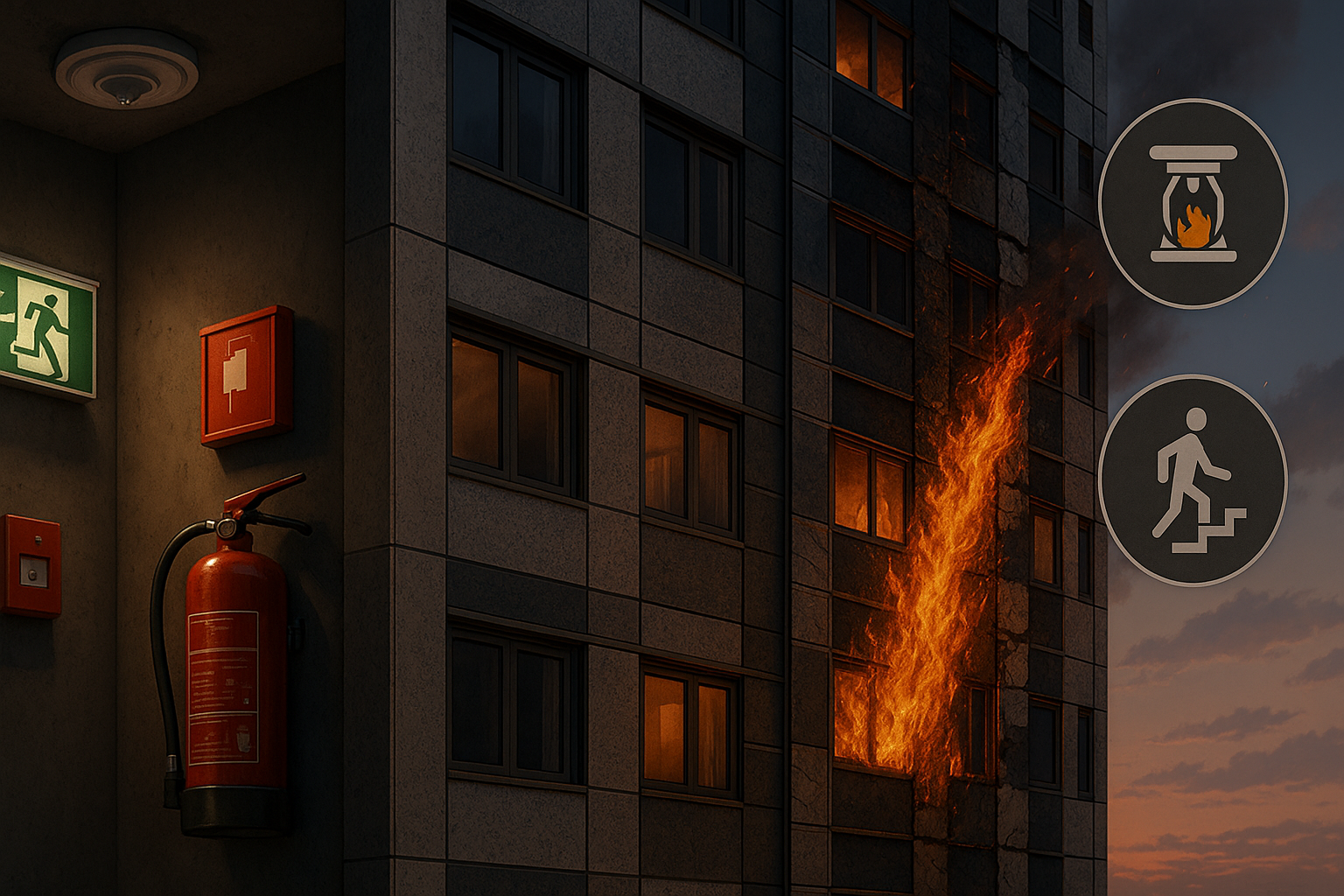Your cart is currently empty!
Category: Fire safety
-

Lessons from the Grenfell Tower Fire: A Comprehensive Analysis
On 14 June 2017, a kitchen fire in Flat 16 of Grenfell Tower—a 24‑storey residential block in North Kensington, London—escalated into one of the deadliest modern high‑rise conflagrations. By the time the blaze was extinguished, 72 people had perished and dozens more were injured or displaced—exposing a cascade of preventable safety failures: from combustible cladding and flawed evacuation policies to fractured regulatory oversight. In this post, we unpack the critical breakdowns, trace the ensuing inquiry and reforms, and lay out actionable lessons for facility managers, EHS professionals, landlords, and homeowners alike.
1. Rapid Fire Spread: The Cladding Catastrophe
1.1 Combustible ACM Panels
- Aluminium Composite Material (ACM): The tower’s 2015–16 recladding used ACM panels with a polyethylene core, a highly flammable plastic that fed the vertical “chimney effect,” carrying flames up the façade in under 20 minutes .
- Burning Dynamics: When ignited, molten droplets from the polyethylene core fell to lower floors, igniting debris and accelerating the spread .
1.2 Misleading Certifications & Cost‑Cutting
- Regulatory Loopholes: Manufacturers and installers exploited gaps in fire‑performance testing requirements, submitting outdated data to secure planning approval .
- Value Engineering: The original specification called for non‑combustible insulation, but a switch to cheaper polyethylene‑cored panels went unchallenged by building control .
2. Evacuation Policy Breakdown
2.1 “Stay Put” Doctrine
- Standard Practice: UK high‑rise regulations prescribe that residents remain in their flats during fires to leverage compartmentation.
- Fatal Misapplication: Once flames breached multiple flats via the cladding, the “stay put” instruction trapped occupants in deadly smoke and heat .
2.2 Conflicting Instructions & Panic
- Mixed Messages: As conditions worsened, some residents were first told to stay put, then abruptly ordered to evacuate—leading to confusion in smoke‑filled stairwells.
- Lack of Real‑World Drills: No evacuation scenario had anticipated a rapid external façade failure; residents and staff were unprepared for a full‑building exit in minutes.
3. Regulatory & Oversight Failings
3.1 Fragmented Responsibility
- Multiple Stakeholders: The council, building-control inspectors, architects, contractors, and fire authorities each assumed safety was “someone else’s” duty .
- Paper‑Driven Inspections: Audits focused on documents over practical tests—there was no requirement to verify the as‑installed cladding against certified samples .
3.2 Weak Enforcement & Whistle‑blowing Gaps
- Lenient Penalties: Non-compliance often resulted in slow or absent follow‑up, emboldening cost‑cutting and design shortcuts.
- Silenced Concerns: Workers and residents who flagged safety issues were sidelined or ignored, perpetuating a culture of complacency.
4. The Public Inquiry & Legislative Reforms
4.1 Inquiry Phases & Key Findings
- Phase 1 (March 2020): Detailed the events of the night, highlighting alarm failures and emergency‑service challenges .
- Phase 2 (September 2024): Delivered 58 recommendations, including a full ban on combustible cladding, mandatory resident engagement, and streamlined regulatory oversight .
4.2 Building Safety Act 2022
- New Regulator: The Building Safety Regulator, housed within the Health & Safety Executive, now oversees “high‑risk” buildings (≥18 m) .
- Golden Thread of Information: Mandates a continuous, digital record of design, construction, and maintenance data accessible to residents and authorities .
- Stricter Fire‑Safety Certification: Non‑compliant buildings must produce valid safety certificates before occupation or face enforcement action.
5. Long‑Term Impacts & Community Rebuilding
- Survivor Health: Many evacuees and first responders suffer chronic respiratory, psychological, and cardiovascular issues due to prolonged smoke exposure and trauma .
- Environmental Cleanup: Soil and water around the site remain contaminated by debris and toxic residues, requiring multi‑year remediation.
- Resident Empowerment: Survivor advocacy led to resident‑led safety committees, ensuring community voices drive ongoing safety audits and reforms.
6. Actionable Lessons for EHS Professionals, Companies & Homeowners
- Independent Material Vetting
- Always commission third‑party fire‑performance tests for cladding and insulation—never rely solely on manufacturer certifications.
- Redundancy & Fail‑Safe Design
- Build multiple, independent layers of protection (e.g., sprinklers, pressurised escape routes, external monitors) so no single failure triggers disaster.
- Comprehensive Evacuation Planning
- Conduct multi‑scenario drills (compartment breaches, full‑building evacuations) and update policies after any retrofit or design change.
- End‑to‑End Accountability
- Create a transparent “responsibility matrix” mapping every stakeholder’s duties, with formal sign‑offs at each project stage.
- Resident & Worker Engagement
- Establish protected channels for safety concerns—regular town halls, feedback surveys, and whistle‑blower policies.
7. Enforcement, Fines & Prosecutions: The High Cost of Complacency
In the wake of Grenfell, regulators have signaled zero tolerance for fire‑safety lapses—issuing severe penalties to both organisations and individuals:
- Corporate Fines & Prosecutions:
Under the Regulatory Reform (Fire Safety) Order 2005, businesses face unlimited fines, and directors can be prosecuted for gross negligence. Housing associations and councils have been fined over £100,000 per offence for invalid or missing fire‑risk assessments. - Individual Liability:
Landlords and homeowners are not exempt. Private landlords have received £20,000+ fines and community sentences for installing non‑compliant doors or neglecting smoke‑alarm maintenance—sometimes facing prosecution for endangering occupants.
How It Could Have Been Avoided
A proactive EHS programme—combining independent material testing, regular fire‑risk assessments, and both “stay‑put” and full‑evacuation drills—prevents small oversights from cascading into catastrophe. Clear accountability, documented sign‑offs at every stage, and empowered whistle‑blower channels ensure safety concerns surface well before regulatory intervention.
8. Fire‑Safety Support & Compliance Resources
Whether you oversee a high‑rise block, manage a business premises, or simply want to protect your home, we can help you:
- Downloadable Fire‑Risk Assessment Templates for both commercial and residential properties.
- Golden Thread Compliance Systems, logging every design change, inspection, and drill in a secure digital platform.
- Staff & Resident Training Programs covering multi‑scenario evacuation planning and proper use of firefighting equipment.
- Quarterly Compliance Audits & Legislative Updates to keep you ahead of evolving fire‑safety regulations.
🛡️ Homeowner Tip:
Install and test smoke and CO alarms on every floor monthly. Replace batteries yearly and keep a simple log of your checks—this small practice can be the difference between an early alert and a legal prosecution.
By integrating these Grenfell Tower fire safety lessons—from rigorous material vetting and evacuation planning to robust accountability and community engagement—you safeguard lives and protect against devastating financial and legal repercussions. Get in touch today for tailored fire‑safety resources and compliance support, and let’s build a safer future together.
